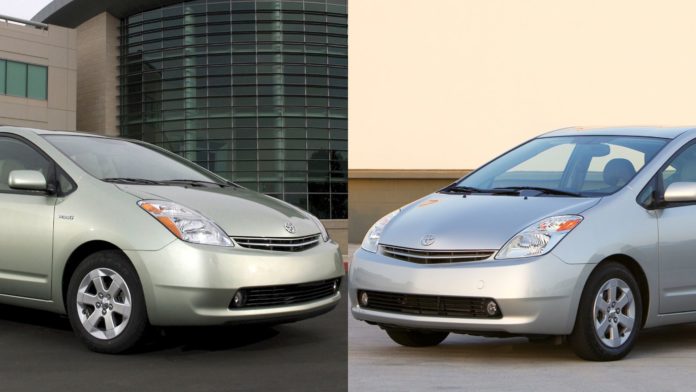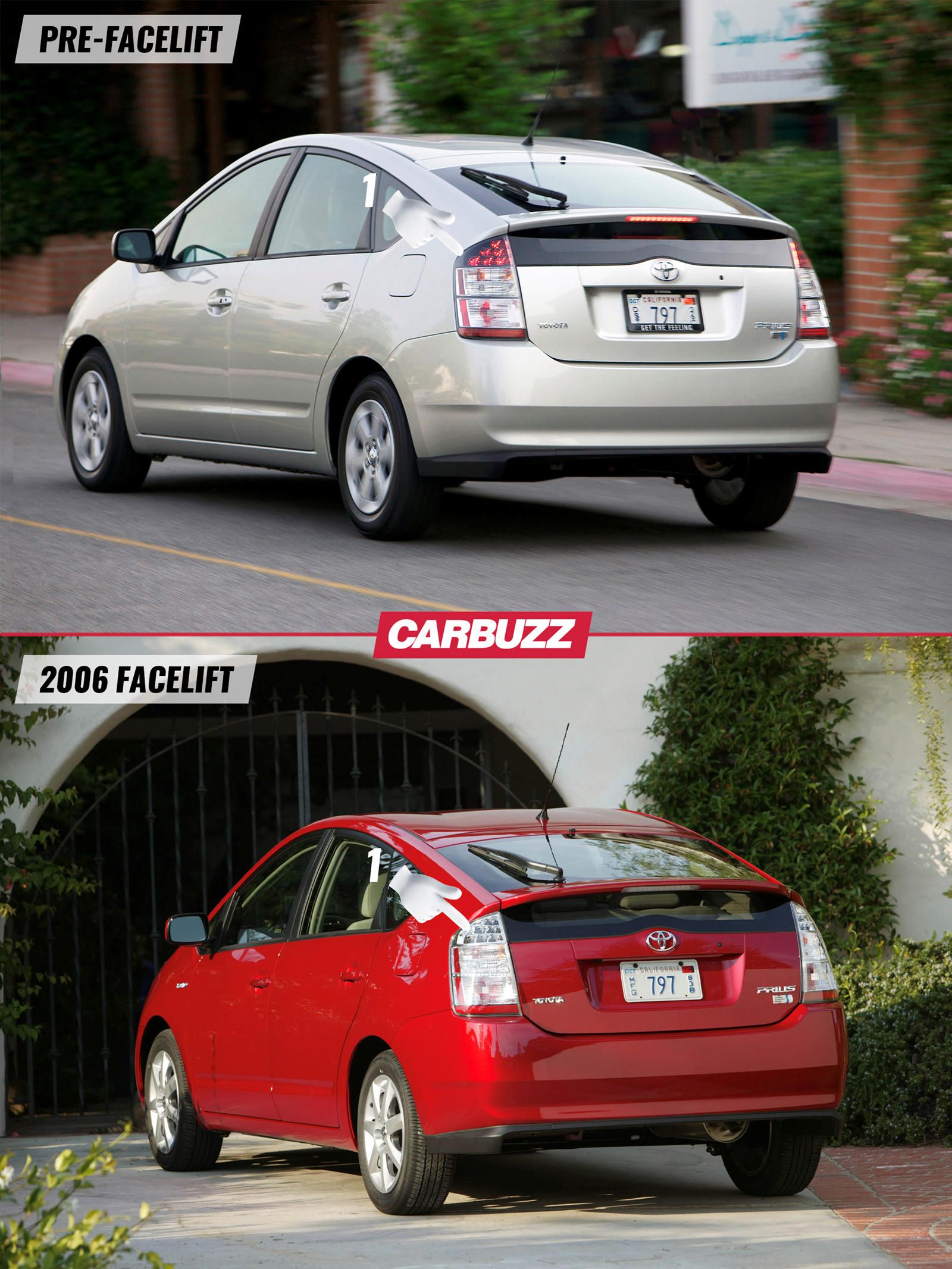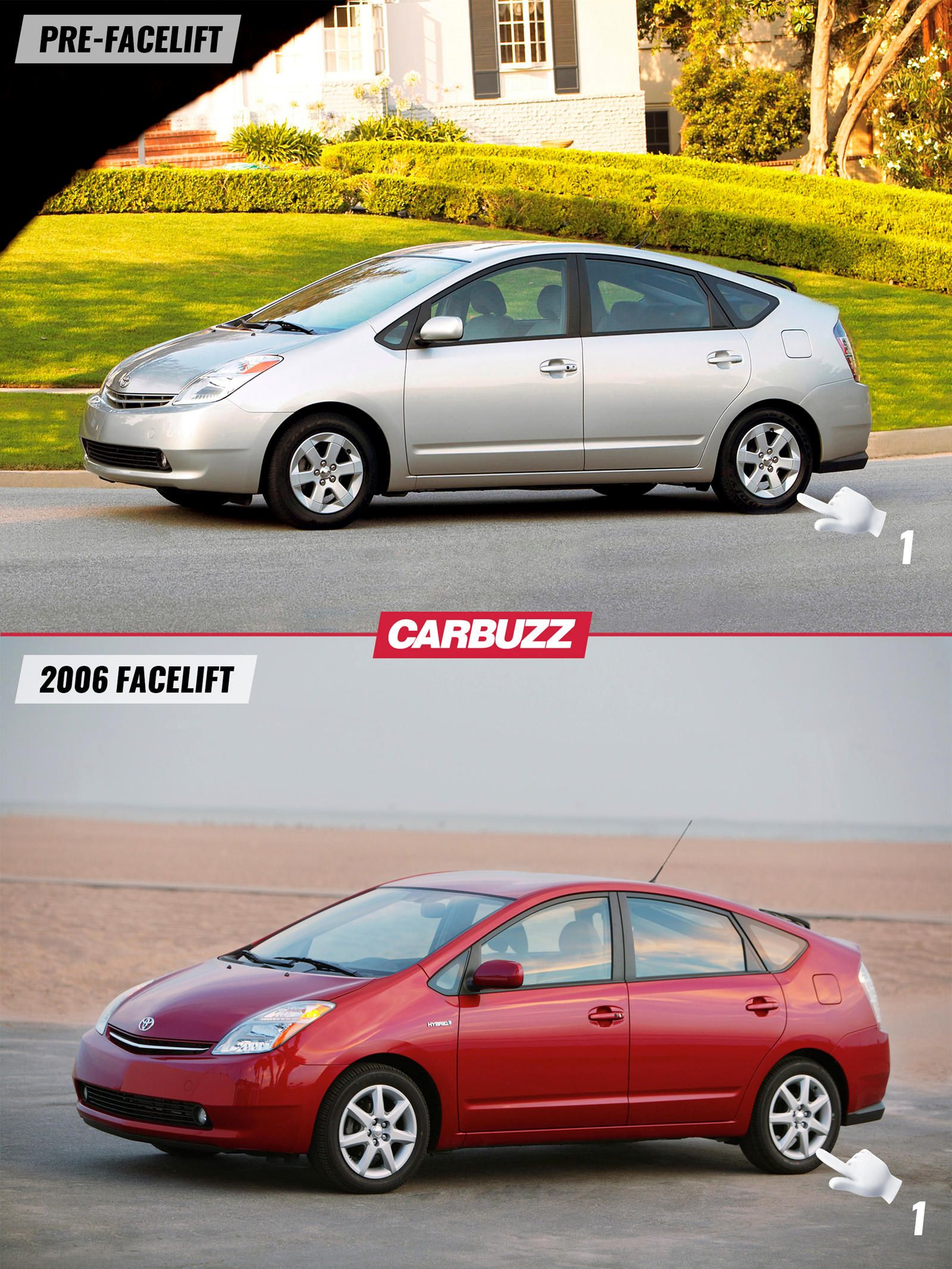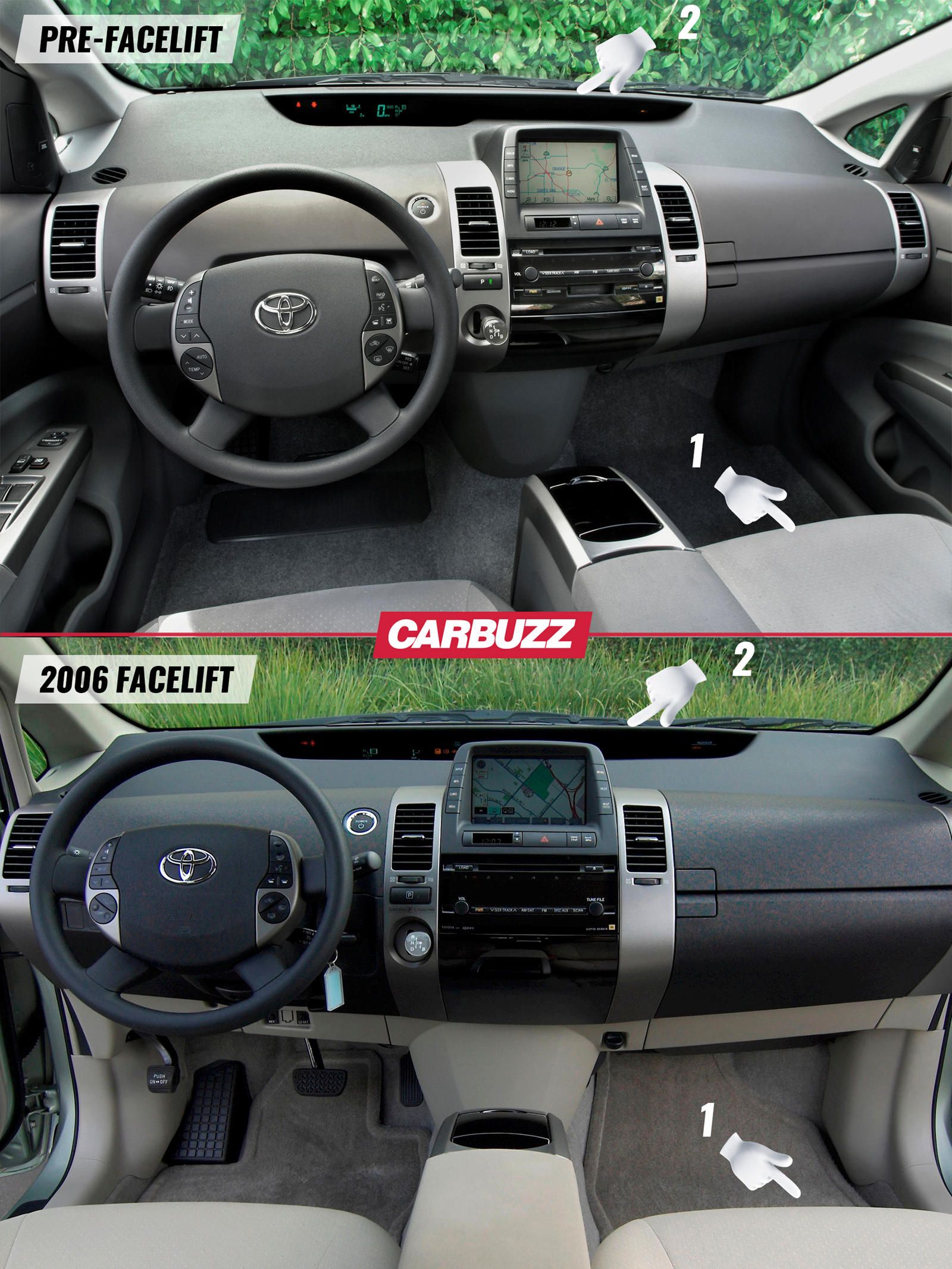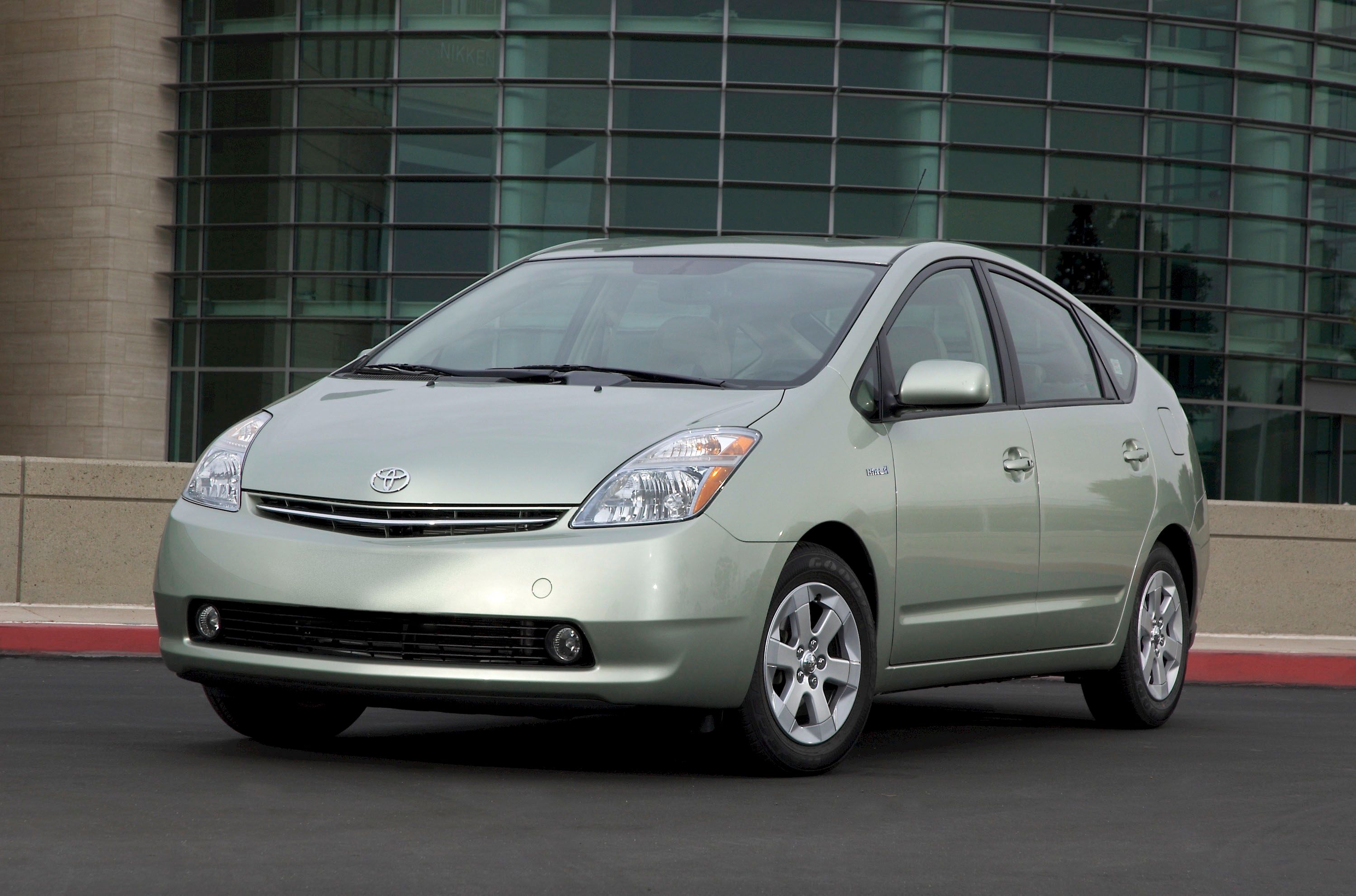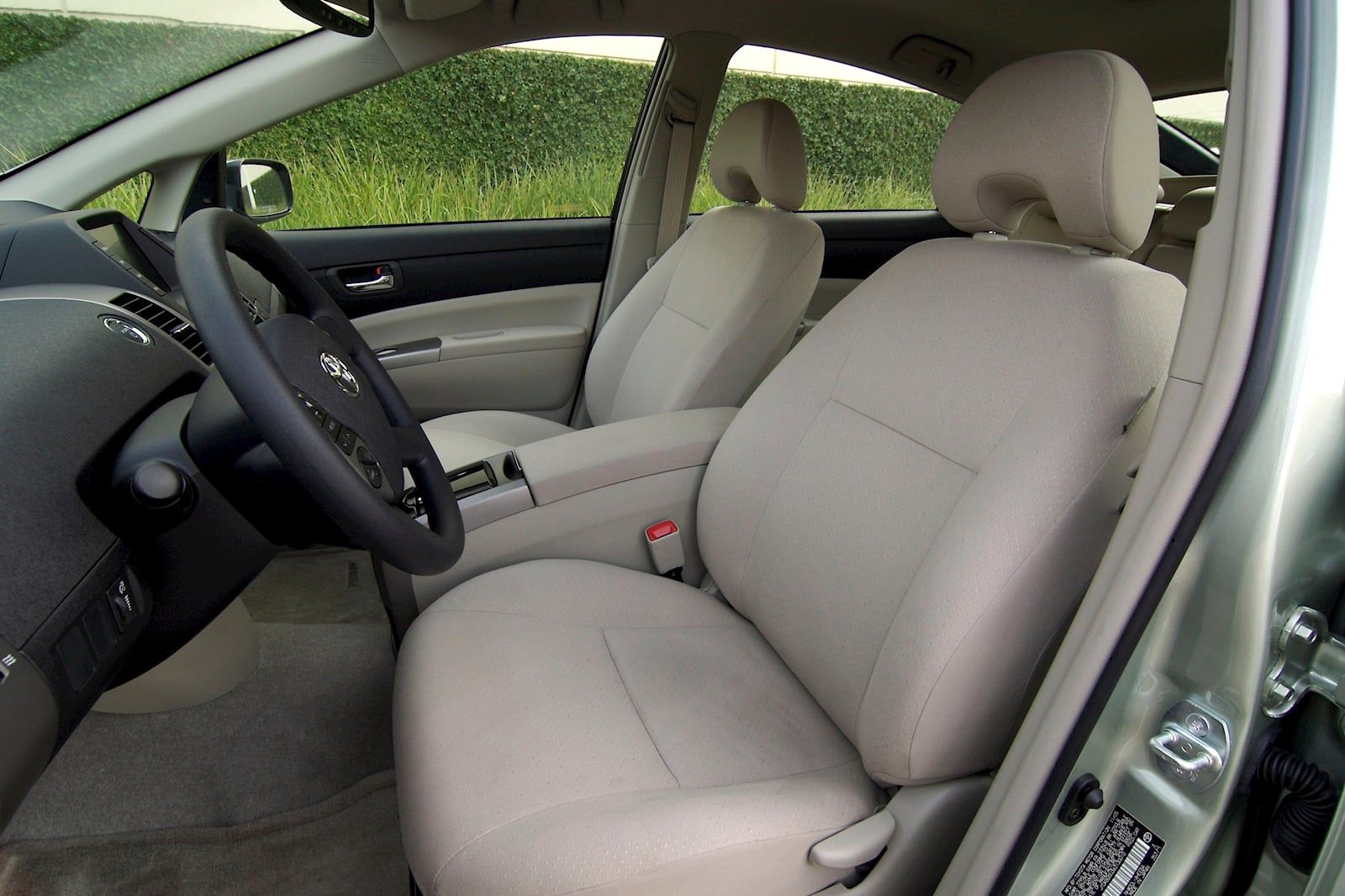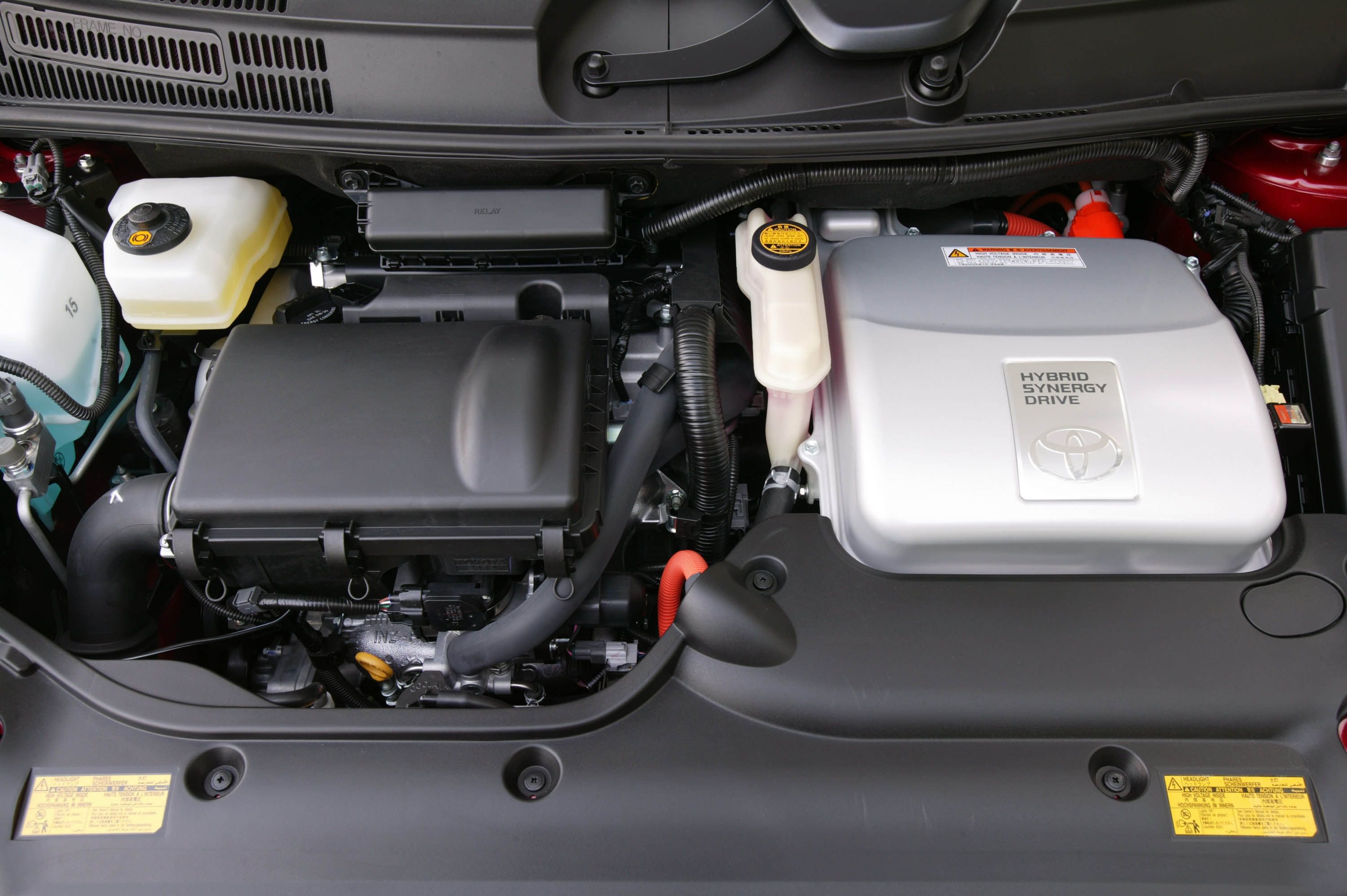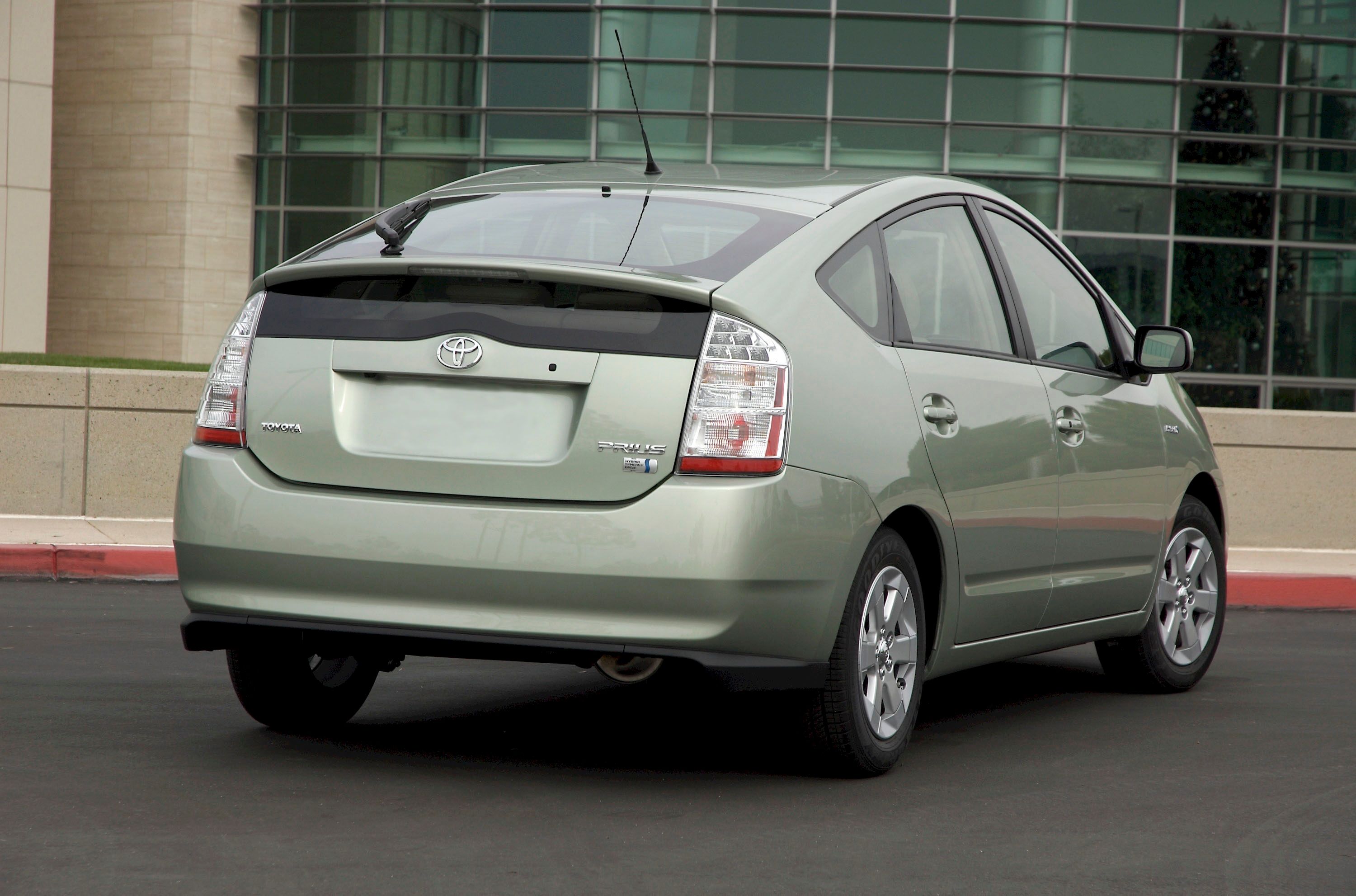2nd-Gen Prius: What Owners Say
- Owners love the excellent fuel economy of the2nd-gen Prius
- There is enough space inside for four adults and the trunk is a decent size, combined with hatchback versatility
- Build quality is universally praised
- Sit back and take it easy, because the Prius is slow
- In some conditions, especially cold weather, owners don’t get the EPA gas mileage figures
- Owners have to deal with a few too many persistent problems, especially in terms of oil consumption, once the miles pile up
Second-Generation Toyota Prius Facelift
The 2nd-generation Prius received only one facelift for the 2006 model year and the changes were so slight that they can easily be missed.
New headlights are fitted, but they retain the shape of the old ones . The main headlight lens is a bit taller, and the turn signal above it is a bit smaller. On the side of the cluster, the previous amber side marker light adjacent to the turn signal gets supplemented with an extended amber reflector below it in the new headlight design (1).
The new taillight clusters no longer have the dark top section to blend in with the darkened glass on the liftgate but are now clear from top to bottom (1).
In profile, only the new wheel designs can be seen (1).
No changes are made to the cabin design, but darker seat cloth is used (1), and the center of the instrument panel gets a different texture (2).
Engine, Transmission and Drivetrain
There was only one drivetrain for the 2004-2009 second-generation Prius – Toyota’s Hybrid Synergy Drive comprising a 1.5-liter Atkinson-cycle inline-four coupled to an electric motor and 1.31-kWh Ni-MH battery.
1.5L Inline-4 Gas Atkinson-Cycle DOHC 1NZ-FXE and One Electric Motor
|
Horsepower |
Torque |
Transmission |
Drivetrain |
|---|---|---|---|
|
76 hp |
85 lb-ft |
CVT automatic |
FWD |
Electric motors: One permanent-magnet AC synchronous electric motor
Horsepower: 67 hp
Torque: 295 lb-ft
Engine + electric motor hybrid system output: 110 hp
The naturally-aspirated 1.5-liter 1NZE-FXE inline four-cylinder engine runs the Atkinson combustion cycle and a 13:1 compression ratio to optimize efficiency and develops only 76 hp and 82 lb-ft of torque. The electric motor contributes 67 hp and 295 lb-ft for combined power output of 110 hp. Toyota doesn’t say what the combined torque output is. Drive to the front wheels is either via the gas engine and continuously variable transmission (CVT), via the electric motor alone, or with both working at the same time for maximum performance. Either way, the Prius is no speed machine, taking ten seconds to reach 60 mph. It’s extremely efficient, though, delivering a 46-mpg combined EPA estimate and qualifying as both a Super Ultra Low Emissions Vehicle (SULEV) and Advanced Technology Partial Zero Emission Vehicle (AT-PZEV) at launch. It’s generally reliable too, but oil consumption can become a problem with age.
The battery’s charging and discharging are computer-controlled, permanently shallow-cycling it between 40% and 80% capacity, ensuring a long service life. In fact, some of these batteries are reported to reach 200,000 miles. Regenerative braking allows the vehicle to harvest some braking energy to recharge the battery and, being a full series-parallel hybrid, it never has to be plugged in.
2004-2009 Toyota Prius 2nd Generation Real MPG
Fuel economy is what it’s all about with a Prius and the stellar figures the second-generation Prius XW20 generates make the lack of performance a lot more palatable. Being a hybrid that switches off its gas engine in traffic, its city consumption is better than its highway consumption, and the EPA estimate of 46 mpg combined is borne out by the real-world consumption figures of owners, which range from 45.9 to 47.7 mpg. With an 11.9-gallon gas tank, a Prius should be able to travel nearly 550 miles. The battery and hybrid system are affected by cold weather, which also causes the gas engine to run for longer periods of time, so general gas mileage in winter is reported to be noticeably worse than in summer.
|
EPA MPG (CITY/HIGHWAY/COMBINED) |
REAL-WORLD COMBINED MPG* |
|
|---|---|---|
|
1.5 inline-four naturally aspirated hybrid FWD CVT automatic |
48/45/46 |
45.9-47.7 |
* Real-world mpg and MPGe figures are provided by the EPA. Once a car has been on sale for a significant period of time, the EPA gets real-world figures directly from the customer base. These figures are then provided on the EPA website. Real-world figures are not available for certain models due to a lack of sales, or not enough people partaking in this after-sales survey.
Safety
The second-gen Prius was tested according to the NHTSA’s less-strict pre-2011 crash-test criteria and fared well, scoring five stars for the driver’s frontal impact and four stars for the rest. For the 2006 model year, it lost that fifth star for the driver’s frontal impact. A 2007 safety update made side and curtain airbags standard, upping the score for the driver’s side impact to five stars.
Back in 2004, safety features were thin on the ground, and driver-assistance features were limited to parking sensors – if you were lucky. The 2004 Prius is kitted out about as expected in terms of safety, having ABS brakes, traction control, and dual airbags as standard – but that’s it. Stability control, side airbags, and curtain airbags were available but had to be selected from the options menu, so check whether they have been fitted. The same goes for xenon headlights. The 2006 facelift brings with it standard tire-pressure monitoring, and a backup camera becomes optional. From 2007 onward, the side and curtain airbags are standard.
US NHTSA Crash Test Result
|
2006 |
2007-2009 |
|
|---|---|---|
|
Frontal Barrier Crash Rating (Driver) |
4/5 |
4/5 |
|
Frontal Barrier Crash Rating (Passenger) |
4/5 |
4/5 |
|
Side Crash Rating (Driver) |
4/5 |
5/5 |
|
Side Crash Rating (Passenger) |
4/5 |
4/5 |
|
Rollover Rating |
4/5 |
4/5 |
2nd-Generation Toyota Prius XW20 Trims
There was only one 2nd-generation Toyota Prius trim for the first three model years, the specification level of which could be varied by adding options at extra cost. More standard features are added every year. For the 2007 model year, the Touring trim is added at the top of the lineup and, for 2008, a new decontented entry-level delete package is available below the existing Base trim.
2004-2009 Base
|
Engine |
Transmission |
Drivetrain |
|---|---|---|
|
1.5-liter naturally aspirated inline-four gas hybrid |
Continuously Variable Automatic (CVT) |
FWD |
On the outside, the 2004 model has 15-inch alloy wheels, halogen headlights, powered and heated body-color side mirrors, and a rear spoiler. Standard equipment on the inside includes remote keyless entry with push-button start, cruise control, a multi-information display showing the hybrid system’s workings, a manually tilting steering column, power windows and door locks, dual front and rear cupholders, cloth upholstery, a 60/40-split and folding rear seat, automatic climate control with a cabin filter, two 12-volt power outlets, and an AM/FM radio/CD player with six speakers. Via any of up to nine different packages (number varies by year), various extra items can be added, such as xenon headlights, foglights, side and curtain airbags, Bluetooth, voice-activated DVD navigation, and an upgraded nine-speaker JBL audio system, so check the spec sheet for the fitted packages. The 2005 model is virtually identical, save for the addition of a standard rear-window wiper and the sun visors being covered in fabric instead of vinyl.
Along with the 2006 facelift comes more equipment, notably, standard tire-pressure monitoring. New optional extras not previously available include leather upholstery, a leather-trimmed steering wheel, an audio jack, and a backup camera. The Standard arrives only for the 2008 model year and slots in at the bottom of the lineup. It is not really a trim and just a decontented Base, so it is mostly similar to the 2008 Base trim described below, with two exceptions – it has no access to any of the optional packages, and a few of the standard features are deleted, notably the heated side mirrors and the cruise control. It has a different wheel design, but it remains a 15-inch alloy.
2007-2009 Touring
|
Engine |
Transmission |
Drivetrain |
|---|---|---|
|
1.5-liter naturally aspirated inline-four gas hybrid |
Continuously Variable Automatic (CVT) |
FWD |
The Touring trim joins the lineup for 2007 and is differentiated by its 16-inch alloy wheels, firmer sport-tuned suspension, standard xenon headlights, foglights, and a larger rear spoiler. In terms of interior appointments, it has everything the 2007 Base Prius has.
Second-Generation Toyota Prius Features
|
BASE |
TOURING |
|
|---|---|---|
|
ABS |
S |
S |
|
A/C |
S |
S |
|
Auxiliary Audio Input |
O |
O |
|
Back-Up Camera |
O |
O |
|
Bluetooth Connection |
O |
O |
|
Brake Assist |
S |
S |
|
Climate Control |
S |
S |
|
Cruise Control |
S |
S |
|
Driver Air Bag |
S |
S |
|
Front Head Air Bag |
O |
S |
|
Front Side Air Bag |
O |
S |
|
Keyless Entry |
O |
O |
|
Keyless Start |
O |
O |
|
MP3 Player |
O |
O |
|
Navigation System |
O |
O |
|
Passenger Air Bag |
S |
S |
|
Power Mirror(s) |
S |
S |
|
Premium Sound System |
O |
O |
|
Rear Head Air Bag |
O |
N/A |
|
Rear Side Air Bag |
O |
N/A |
|
Satellite Radio |
O |
N/A |
|
Stability Control |
O |
O |
|
Steering Wheel Audio Controls |
S |
S |
|
Tire Pressure Monitor |
S |
S |
|
Traction Control |
O |
O |
|
Universal Garage Door Opener |
O |
O |
Interior, Trim And Practicality
The interior is not plush by any means, but the ambiance is lifted by dabbling in the options list and adding features such as leather upholstery. What cannot be faulted is the durability of it all, and everything is bolted down securely, giving an impression of longevity. The tech on offer is good, and the driver has to try not to be distracted by the multi-information screen displaying in real time what the hybrid drive is up to and where the power is coming from. It’s also commendably spacious inside, with 38.6 inches of rear legroom, even if the 37.3 inches of headroom back there is somewhat limited by that sloping roofline. There is also an ample 14.4-cubic-inch trunk, its practicality aided by the hatchback design.
|
BASE |
TOURING |
|
|---|---|---|
|
Bucket Seats |
S |
S |
|
Cloth Seats |
O |
O |
|
Leather Seats |
O |
O |
|
Leather Steering Wheel |
O |
O |
|
Premium Synthetic Seats |
O |
O |
|
Vinyl Seats |
O |
O |
|
FABRIC SEAT TRIM |
S |
S |
|
LEATHER SEAT TRIM |
O |
O |
|
Dark gray, fabric seat trim |
S |
S |
|
Bisque, fabric seat trim |
S |
S |
|
Dark gray, leather seat trim |
S |
S |
|
Bisque, leather seat trim |
S |
S |
|
Fabric Seat Trim |
S |
S |
|
Leather Seat Trim |
S |
S |
|
Cloth Seat Trim |
S |
N/A |
2004-2009 2nd Gen Toyota Prius Maintenance and Cost
The Prius’ minor lube services are performed every 5,000 miles, but there is a bigger service at 30,000 miles when the air filters for the cabin and engine have to be replaced as well. The 30,000-mile service costs about $340 at an independent shop or $570 at Toyota. If you’re buying it yourself, the air filter will cost about $60, which is quite steep and double the price of an air filter for a typical car in this class. The cabin air filter’s price is $22. At 100,000 miles, the inverter’s coolant must be replaced, which means that this service cost around $460-$680 and at 120,000 miles, the transmission fluid must be replaced, which is why this service costs $835 – $1,210. However, this is pushing things a bit for a CVT and in view of the steady number of transmission complaints recorded, we’d halve that transmission fluid replacement to 60,000-mile intervals in the interest of transmission longevity.
The spark plugs must be replaced at the same 120,000-mile service, and if you do it yourself, a set of four will cost you about $42. The only spark plug replacement problems on a Toyota Prius engine you’re likely to run into is that they might be difficult to remove from the cylinder head after such an extended period, so take care not to break them. After 100,000 miles, you can also expect the hybrid battery pack to let go at short notice, even if it can last quite a while longer in some instances. A remanufactured one with a five-year warranty should cost no more than $2,000. Having a new one installed by Toyota will set you back at least $3,500.
Second-Gen Toyota Prius Basic Service
The basic service requires the engine oil and filter to be replaced every 5,000 miles or six months, whichever comes first. We would not budge from this mileage one little bit because in a hybrid, the engine oil breaks down faster due to the engine often switching off and being restarted, rarely reaching operating temperature in city traffic. Also, the majority of the engine problems on the 1NZ-FXE are oil-related, and you can defer oil consumption and cam chain problems by frequently replacing the oil. To add insult to injury, the engine’s oil capacity is only 3.9 quarts, so your biggest problem after an oil change on a 2004-2009 Toyota Prius is keeping a hawk’s eye on the oil level – any leak or oil-consumption issue leaves little leeway and will have the oil running dangerously low very quickly.
This lube service should not cost more than $170 at an independent shop or $335 at Toyota. Check the oil level frequently and use only fully synthetic oil. This basic service is repeated every 5,000 miles, but various other items are checked and inspected along the way, depending on the mileage. The 5W-30 oil type and oil filter for this normal lube service shouldn’t cost much more than $53 if you’re going to do it yourself.
2nd-Generation Toyota Prius XW20 Tires
Base
Tire Size: P185/65R15
Wheel Size: 15″ x 6.0″
Spare Tire: T125/70D16
Touring
Tire Size: P195/65R16
Wheel Size: 16″ x 6.0″
Spare Tire: T125/70D16
Check Before You Buy
There weren’t too many 2004-2009 Toyota Prius hybrid recalls:
- The 2004-2009 Toyota Prius steering recall was issued to replace a steering intermediate extension shaft made of splines of an insufficient hardness, causing them to wear away, leading to a loss of steering ability. An additional steering recall on 2004-2006 models replaced the intermediate shaft and sliding yoke, both of which may fracture under stress – this power-steering problem on 2004, 2005, and 2006 Toyota Prius models is the only other one of note.
- Toyota recalled 2004-2009 Priuses to replace the inverter’s electric water pump that might have suffered internal damage during manufacturing, causing a short that makes the hybrid system shut down, leading to a stall. On a 2004-2009 Prius, P0a93 is the error code that usually accompanies an inverter-cooling problem.
- As part of Toyota’s unintended-acceleration scandal involving nearly 4.5 million vehicles, all 2004-2009 Prius models were recalled to replace or refund floormats that may cause the accelerator pedal to jam, as well as replace and modify pedals and floor surfaces, as required.
- There were a few recalls relating to the restraint system. In a recall of the 2004-2006 Prius, Toyota replaced improperly assembled airbag inflators that may not inflate some of the airbags properly, and a recall on 2009 models was issued to recalibrate the occupant-detection sensors that may otherwise fail to deploy some of the airbags in a crash. There was no 2007 or 2008 Toyota Prius airbag recall.
- The 2004 Toyota Prius was recalled to replace a brake light switch that may fail. On a 2004-2009 Prius, P0571 may be the accompanying error code.
- Many Toyotas, including the 2005-2009 2nd generation, were recalled to replace incorrect load-capacity labels.
Some of the typical OBD-II error codes you might encounter on a 2004-2009 Prius are:
- The P0001 and P1159 error codes are fuel-system-related codes. P0001 indicates a problem with the fuel-volume regulator and P1159 means the fuel-rail pressure is too high. P0201 on a 2004-2009 Prius is a fuel-injector error code.
- On any 2004-2009 Prius, P0011, P0012, P0016, P0391, P0394, P093a, and P0391 are cam position error codes.
- The P0031, P0037, P0038, P0136, P0137, P0138, P0171, P0172, P0420, and P0880 codes on 2004-2009 Priuses are related to the oxygen sensors or their readings.
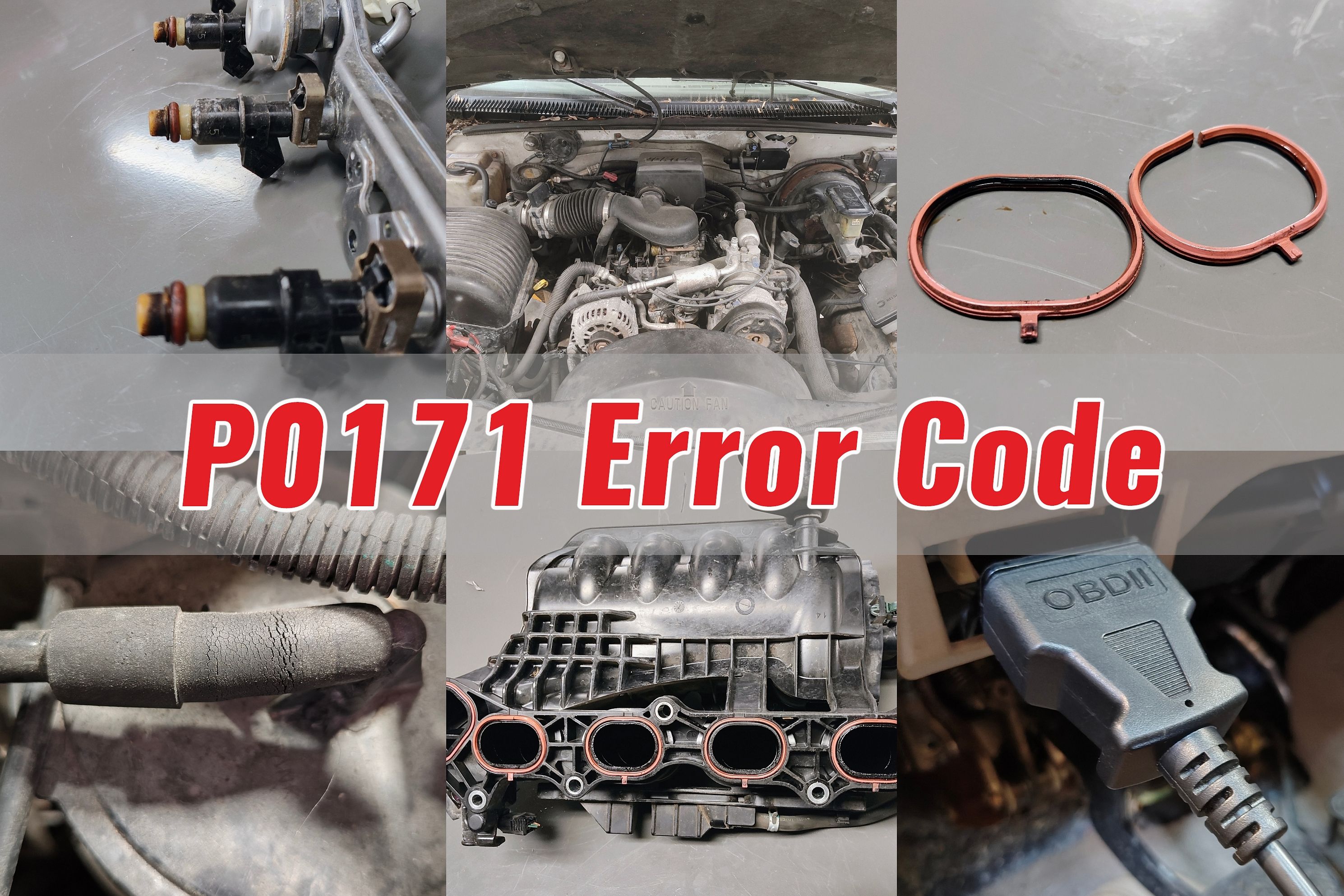
Related
P0171 Error Code: What It Is And How to Fix It
If your car has a rough, erratic idle and triggers the P0171 error code, there’s likely an issue with the air-to-fuel ratio.
- P0100, P0101, P010a, and P1101 on 2004-2009 Priuses are error codes from the mass airflow (MAF) sensor.
- P0113 is an intake-air temperature (IAT) error code.
- On a 2004-2009 Prius, P0117, P1116, P1117, P1121, P1122, P1123, P1150, and P1151 are engine coolant error codes. P0117 is an engine coolant temperature (ECT) error code, and both P1116 and P1117 indicate a low coolant level. P1121, P1122, and P1123 are coolant-flow control-valve error codes. P1150 usually indicates an overheating condition, and P1151 shows a problem with the coolant heat-storage tank.
- On any 2004-2009 Prius, P0121 and P1120 are throttle-position sensor (TPS) error codes.
- P0300 is a random misfire error code and, if the last digit is not a zero, it indicates the number of the cylinder misfiring, so P0301, P0302, P0303, and P0304 on 2004-2009 Priuses indicate a misfiring cylinder on one, two, three, or four, respectively. P0351, P0352, P0353, or P0354 indicate that ignition coil A, B, C, or D, respectively, is malfunctioning.
- P0401 is an exhaust-gas recirculation (EGR) sensor error.
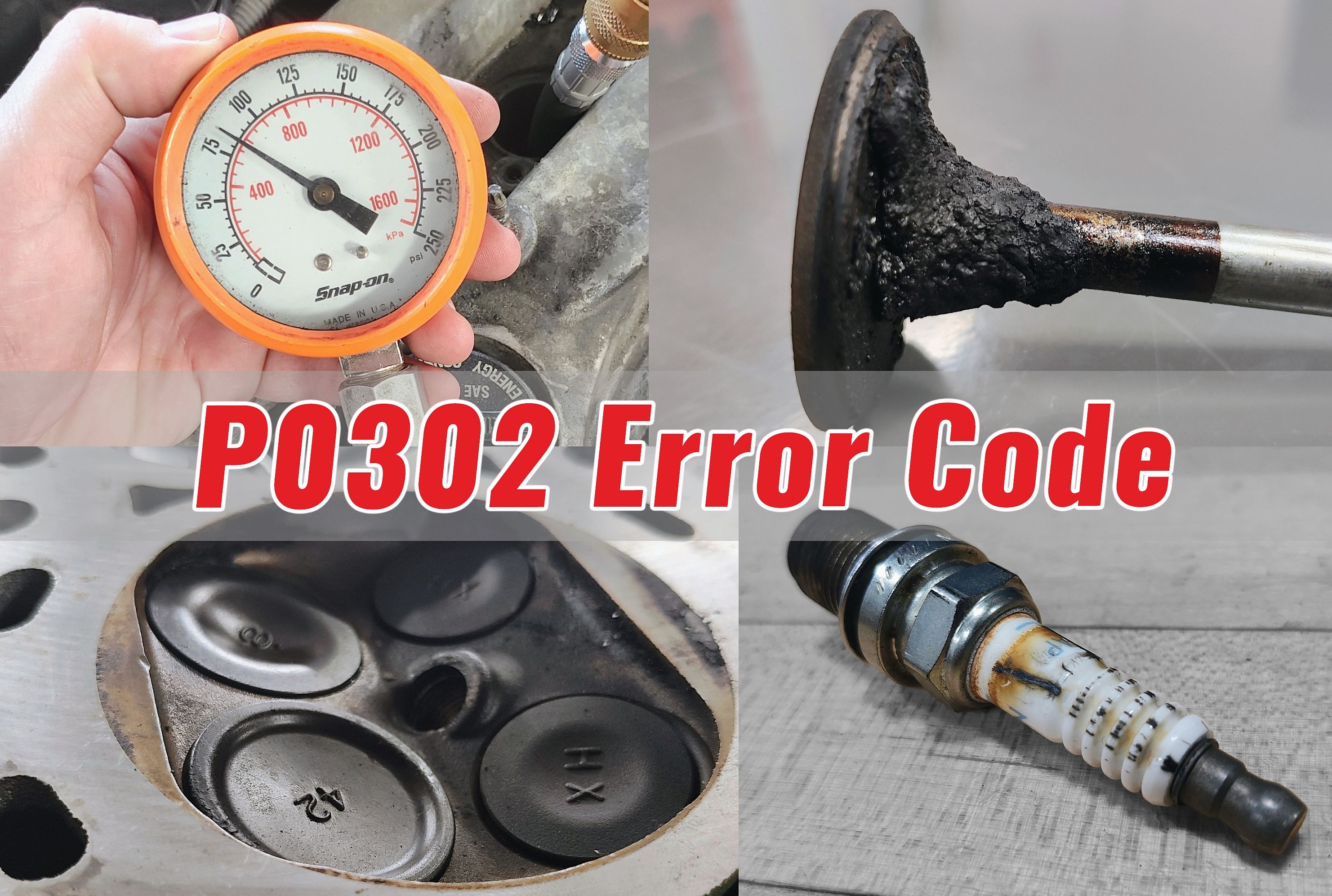
Related
P0302 Code: What It Is And How To Fix It
Lack of power? Reduced fuel economy? Your engine may be misfiring and require urgent intervention.
- On a 2004-2009 Prius, P0441, P0446, P0455, P0456, and P1455 are evaporative emissions control (EVAP) system error codes.
- P0505 is an idle-air control system error code.
- P1106 is a barometric pressure-sensor error code.
- On a 2004-2009 Prius, P0517, P09ac, P0a9c, P0a82, P0aa0, P0ac0, P1a10, and P3000 are hybrid battery-pack error codes. P0517, P09ac, and P0a9c are temperature-sensor errors. P0a82 indicates a problem with one of the battery pack’s cooling fans. P0aa0 is a batter contactor-circuit error. P0ac0 is a current-sensor circuit error, and P1a10 indicates that the hybrid system has been shut down to prevent the traction battery from discharging. P3000 is a battery-control-system error.
- The P0600, P0606, P0607, and P0630 error codes indicate a problem with the electronic control module (ECM).
- P0705 and P0825 are transmission error codes. P0a3f means there is a problem with the motor resolver (which is a transaxle speed sensor).
- On a 2004-2009 Prius, P0a09, P0a94, P0a0a, and P0a0d indicate problems with the hybrid system. P0a09 and P0a94 are DC/DC converter errors, and both P0a0a and P0a0d are high-voltage system interlock errors.
- P0a0f is an engine non-start error code.
- P0a1d is a hybrid-system control-module error code.
- P0a2d is a drive-motor temperature error code.
- On a 2004-2009 Prius, P0a40, P0a46, P0a78, P0a7a, and P0a93 are drive-motor errors. P0a40 and P0a46 are position-sensor errors, while P0a78, P0a7a, and P0a93 are inverter error codes.
- P0a4c and P0a4d are generator position-sensor errors.
- P0aa6 means there is a high-voltage leak.
2004-2009 Toyota Prius Common Problems
1NZ-FXE 1.5-liter Inline-Four Engine Problems
The NZ dates all the way back to the late ’90s, and by the time it made its appearance in the 2004 Prius, it had gained features such as hydraulic valve lifters and roller rockers; alongside the cam chain, these features make it virtually maintenance-free except for frequent oil changes. Those oil changes are important because, like some other engines with low-tension, low-friction piston rings, these rings can become stuck – and when they do, oil consumption increases and can become as excessive as a quart per 500 miles. Unnoticed low oil levels can lead to many other problems, like overheating and greatly increased wear, eventually ruining the engine.
Oil can also come past the valve-stem seals and be burnt by the engine. The cam chain is a narrow, low-friction, single-row item and can become elongated and start to rattle, necessitating its replacement. Its tensioner can fail as well. The VVT actuators will also fail earlier if the engine is neglected and they need clean oil to last. All these problems don’t generally rear their heads before 100,000 miles, and if you religiously change the oil, you can defer problems for a long time. It is, therefore, critical to examine a used Prius’ service history. Remember that the oil in the Prius engine works hard, as the engine is started and stopped all the time by the hybrid system and runs below proper operating temperature a lot of the time. This taxes the lubricating properties and additives of the oil and requires more frequent oil changes.
In common with many engines – and certainly not unique to the 1NZ-FXE – other problems appear with the advancing years and among these are the inevitable oil leaks. In the case of the 1NZ-FXE, oil leaks usually originate at the rear main or the valve or chain-tensioner covers. Due to these oil leaks, oil can penetrate the crankshaft-position sensor’s connector, causing it to stop operating and this can cause an engine stall, which is why there was a recall for it. Make sure the recall work has been done. Other issues that go hand in hand with high mileages on many engines – and also affect this one – is poor running due to a dirty throttle body, dirty idle-speed sensor, or stuck PCV valve.
Mileage: Excessive oil consumption can start at 100,000-147,000 miles. Failed valve-stem seals, elongated cam chains, and dodgy cam-chain tensioners aren’t usually a problem before 100,000 miles and can be postponed beyond that with frequent oil changes. Neglect brings on failures faster.
Cost: Invasive engine work to replace the piston rings can cost north of $4,500. You might also have an ongoing expense buying top-up oil between services, should you choose to live with the oil consumption.
How to spot: Naturally, oil consumption will cause the oil level to drop and, if it becomes excessive, spark-plug fouling will cause poor running and smoke may be emitted from the exhaust. Excessively low oil levels will soon terminally damage the engine. An elongated cam chain and/or failed tensioner will cause a rattling sound.
Inverter Coolant Pump Failure
The inverter on the hybrid system of the second-generation Toyota Prius is durable but its coolant pump may fail, putting it at risk of overheating. Luckily, there should be a dash warning light to indicate something is amiss and this will usually be accompanied by the P0A93 OBD-II error code. Some people fit aftermarket coolant pumps, but these are not always reliable – it’s best to go for the OEM item. A recall was issued for this problem, but since this Prius generation is now so old, the problem remains a risk due to the age of the pump. It’s better to be safe rather than sorry, because it’s not an expensive item to replace and can prevent a dangerous stall. The fact that various owners had their pumps replaced and had to pay for them indicates that not all failures are covered by the recall. Failures are typically not reported before 110,000, but one pump failed at 50,000 miles. The potential inverter cooling-pump failure is the only 2004-2009 Toyota Prius inverter problem of note on Touring, Base, or Standard trims – they all use the same pump.
Mileage: Usually around 110,000-122,000 miles on average.
Cost: Around $550 for a pump replacement, labor included.
How to spot: P0A93 OBD-II error code and dashboard warning lights.
Traction Battery Failure
The conservative design of the Ni-MH traction battery and its shallow-cycle charging and discharging regime should see it get to 200,000 miles in some cases, so we don’t regard this as a problem area, so there are very few 2004-2009 Toyota Prius hybrid battery and electric-motor problems to report. The reason why we list it here is because this Prius generation is now old and the likelihood of having to replace the traction battery is high based on the age of these cars. What’s more, it’s an expensive item, so it’s something you’ll have to look out for and perhaps use as a bargaining chip to drive down the price of a used one so you don’t overpay and get value for money. If you opt for a remanufactured battery pack, go for one that has at least a five-year warranty. A Toyota-supplied replacement is safer but more expensive. Some technically minded owners had a go with a DIY battery-overhauling job with mixed results, but if you know what you’re doing, it will cost you little more than time and labor, and you can end up with a working battery. On a 2004-2009 Prius, P0a80 is the error code you’re likely to encounter when it’s time to replace the battery.
Mileage: While the battery can reach 200,000 miles in some cases, failures might happen sooner, especially on old cars. It can expire any time from around 100,000 miles.
Cost: A remanufactured high-voltage traction battery typically varies between $1,500 and $2,000 but you’ll have to do your research, as quality from different suppliers can vary. A five-year warranty is a good indication of quality. Toyota-supplied new batteries will start at around $2,500 before labor and can run to $3,500.
How to spot: The P0A80 OBD-II error code will most likely be triggered in case of an expired traction battery, usually along with the Check Engine Light (CEL) and a little red triangle warning. Other signs are that the vehicle is constantly running on the gas engine and won’t engage the electric drive.
ABS Actuator Failure
2004-2009 Toyota Prius ABS actuator and brake pump problems are quite common. These actuators can fail, and they are extremely expensive to replace, so check that there are no ABS warning lights on the dashboard and that the brakes and ABS work properly. The ABS pump shouldn’t frequently cycle during drives. Total brake failure can follow an ABS actuator failure. The problem is quite common, consistently showing up in annual complaints and is worth looking out for because it is so expensive to fix and can be potentially dangerous. Despite this, there was never a Toyota Prius brake-actuator recall. It seems most prevalent on 2008 models.
Mileage: It seems that this can occur at nearly any mileage, with recorded mileages varying from around 43,000 to 153,000 miles.
Cost: Having Toyota install a new ABS actuator can cost as much as $2,300-$3,400.
How to spot: A lack of ABS intervention, poor or no braking, error codes and dash warnings, and loud and frequent ABS-pump actuation, even during drives.
Multifunction Display Failure
Quite a lot of 2004-2009 Toyota Prius instrument cluster and control-panel problems with the multifunction display – or MFD – were reported. The display going black is usually the fault of a capacitor failure, an extremely cheap part to replace. The problem is that Toyota won’t repair the display and will charge you a small fortune for a new one – some owners report being quoted thousands of dollars. You can have someone with good knowledge of electronics replace the capacitor on the circuit board with a new one, or you can find and fit a used circuit board at a parts shop. This problem seems especially prevalent on 2007 and 2008 models but affects all model years. Besides this, there aren’t any other notable problems with the 2004-2009 Toyota Prius’ fuel gauge, turn signal, cruise control, odometer, speedometer or other dashboard instruments.
Mileage: Around 79,000-142,000 miles on average.
Cost: A replacement capacitor is a dollar or two plus paying someone who knows circuit boards to replace it. A used circuit board is rarely much more than $50. Having Toyota replace the gauge cluster with a new one will cost around $1,400 – divided down the middle for parts and labor. Some owners have been quoted more than $4,000. Used displays can be found for around $300.
How to spot: The multifunction display goes dark.
HID Headlight Problems
2004-2009 Toyota Prius Touring headlight problems are well-documented. The Touring has the HID xenon headlights fitted as standard and the issue affects this trim, as well as other models with the optional HID headlights fitted. These lights might work intermittently or fail altogether. There was no recall, so this became the subject of a class-action lawsuit – Toyota agreed to a settlement and a warranty extension to five years or 50,000 miles on 220,000 2006-2009 Priuses. Better make sure the HID headlights work properly on a nighttime drive and check the VIN with Toyota to determine whether the car you’re looking at is one of the 220,000 eligible for a free fix if the work hasn’t been done already. It’s expensive to remedy if you have to pay for it. And you might have to, because it is commonly reported on 2004 and 2005 models too. Only the 220,000 Priuses under the class action were covered, not the 2004-2005 models and no other models either – there was no 2006, 2007, 2008, or 2009 Toyota Prius headlight recall for the faulty headlights, nor for the 2004 and 2005 models affected to a lesser extent.
Mileage: Around 91,000-155,000 miles on average.
Cost: The average repair cost for this problem is between $250 and $660.
How to spot: The HID xenon headlights work intermittently or not at all.
Smelly Air-Conditioning
Like many other Toyotas, the HVAC evaporator of the 2nd-gen Toyota Prius tends to trap moisture that encourages mildew to grow, emitting a foul smell when the air-conditioning is used. There isn’t much you can do about it except buy a can of AC disinfectant and apply it as instructed. It should kill the bacteria and remove the smell. Just do it again when the smell returns. This is not a fault that can disable the AC. Besides the odd blower-motor failure or defroster issue, the bad smell is by far the most common of the air-conditioning (AC) problems on 2004-2009 Toyota Prius models.
Mileage: N/A
Cost: Around $10 for a can of AC disinfectant.
How to spot: A foul, musty, moldy smell being emitted from the AC vents.
Less Common Problems And Problem-Free Areas
Besides the foul smells on occasion and a defroster that may sometimes not work properly, there aren’t a lot of 2004-2009 Toyota Prius heater/heating or AC problems, and the HVAC system is reliable – but test it properly on a test drive. Should the AC compressor be tired, a replacement will cost over $2,000. The throttle actuator can fail after 100,000 miles, and the job to replace it runs to more than $1,000 with labor. Some problems with paint cracking and peeling, along with some rust and corrosion, are reported at higher mileages, but these aren’t too commonplace. Carefully check for signs of the paintwork deteriorating or corrosion, especially on cars used in rust-belt states with salted roads. While not as widely reported on the 2nd-gen Prius as on other Toyotas, rodents do seem to have an affinity for the Prius’ wiring and it would be wise to check for chewed wiring, rodent droppings, and random, unexplained electrical, charging system, starting, or fuse problems on 2004-2009 Toyota Prius models. Stay clear, because invasive wiring harness repairs can be very expensive.
Some owners of 2006 models have reported that the dashtop can become sticky in hot weather and problems with the 2004-2009 Toyota Prius’ door locks or rear hatch handle’s button mainly revolve around the rubber parts melting, although the actual liftgate latch can also fail. The odd door-lock actuator can fail too and replacing these are quite pricy at $600 a pop. A few owners have found it difficult to fully top up their gas tanks.
CVTs can be unreliable but the unit in the 2nd-generation Toyota Prius seems reliable if the fluid is changed on schedule. As is the case with all complicated mechanical systems, it can fail, but it’s the exception rather than the rule. Failures generally don’t occur before 137,000 miles, although there have been exceptions. It seems to be a surprisingly reliable CVT and most problems with the 2004-2009 Toyota Prius’ acceleration aren’t transmission shifter issues but simply down to the low power output of the engine. If the transmission does give out, a replacement is in the region of $4,500.
With all the major and minor problems covered, you’d be pleased to learn that the following system and subsystems rarely cause problems:
- Besides the fact that it has to be cleaned periodically on old cars and the already-mentioned throttle-actuator issues, there are no notable 2004-2009 Toyota Prius throttle-body problems.
- There aren’t any actual Toyota Prius stereo problems, but it’s worth noting that the upgraded nine-speaker JBL system is far superior to the base audio system.
- The fueling system is reliable and almost no problems with the 2004-2009 Toyota Prius bad gasoline/fuel injectors, oxygen sensor heaters, catalytic converter, lines, pump, and tank are reported, although some owners did mention that the tank can be hard to top up fully.
Which One To Avoid
There isn’t a bad trim in the lineup and while the Standard only takes away a few nice features, losing the cruise control is the most irritating of all; it also didn’t have access to the optional packages, so what you see is what you get. We’d avoid it. The Touring is a little pointless and although the 16-inch wheels look nice, the firmer suspension makes little sense in a slow hybrid. Test it to decide whether you’re happy with the ride quality on poor surfaces before deciding. Going by the huge number of complaints about the Touring’s standard HID headlights, we’d be circumspect of such an important safety feature potentially being unreliable. We’d also avoid any model on which the optional side and curtain airbags and stability control were not specified, as these are important safety features in less-safe old cars like this Prius.
Which One To Buy
We’d go for a 2007 Standard, which has all the most important features of the Touring but with more sensible and cheaper tires, a softer ride, standard side and curtain airbags, and the tweaks from the 2006 facelift. We’d furthermore make sure that the boxes for an upgraded audio system, the stability control, and the backup camera were ticked – the latter is quite an important feature we take for granted nowadays and can go a long way to eliminate visibility problems in the Toyota Prius for people of shorter stature. For ultimate reliability, the 2009 model is the best, registering the fewest oil consumption reports and the fewest faults – barring the optional HID headlights.
2nd-Gen Toyota Prius Verdict
The second-generation 2004-2009 Toyota Prius is a spacious and unpretentious hybrid that delivers on its most important USP – fuel economy. Having said that, you’d have to live with the limp acceleration. Reliability is good, but things tend to start going downhill from 100,000 miles; at this point, oil consumption and battery-pack issues can become prevalent. Negotiate on the price to cover you for a battery replacement and do not even consider a car that has not had fresh engine oil at least every 5,000 miles or six months, because failing that, you’ll certainly have an oil drinker on your hands before long. A meticulously maintained car can last you a long time.

